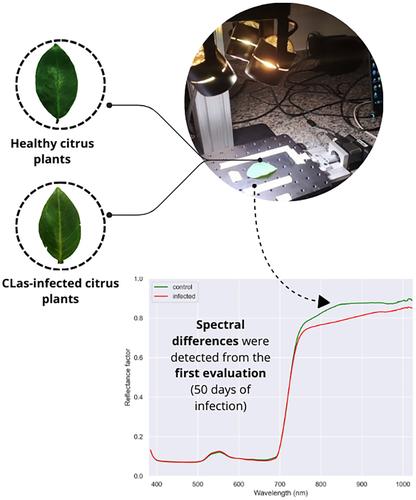当前位置:
X-MOL 学术
›
Pest Manag. Sci.
›
论文详情
Our official English website, www.x-mol.net, welcomes your
feedback! (Note: you will need to create a separate account there.)
‘Candidatus Liberibacter asiaticus’ infection alters the reflectance profile in asymptomatic citrus plants
Pest Management Science ( IF 3.8 ) Pub Date : 2024-11-05 , DOI: 10.1002/ps.8528 Julia GA Vieira, Emile DR Santana, Fagner G Conceição, Fernando Henrique Iost Filho, Juliano B de Pazini, Roberta Rodrigues, Pedro T Yamamoto
Pest Management Science ( IF 3.8 ) Pub Date : 2024-11-05 , DOI: 10.1002/ps.8528 Julia GA Vieira, Emile DR Santana, Fagner G Conceição, Fernando Henrique Iost Filho, Juliano B de Pazini, Roberta Rodrigues, Pedro T Yamamoto

|
BACKGROUNDHuanglongbing (HLB) is the primary and most destructive disease affecting citrus, caused by a pathogen transmitted by an insect vector, Diaphorina citri . There are no curative methods for the disease, and rapid and accurate methods are needed for early detection in the field, even before symptoms appear. These will facilitate the faster removal of infected trees, preventing the spread of the bacteria through commercial citrus orchards.RESULTSIt was possible to determine ranges of hyperspectral bands that demonstrated significant differences in relative reflectance between treatments consisting of healthy and infected plants from the first days of evaluation, when plants infected with ‘Candidatus Liberibacter asiaticus’ (CLas) were still in the asymptomatic stage of the disease. From the Week 2 of evaluation [58 days after infection (DAI) of plants] until the last week, spectral differences were detected in the red edge region (660–750 nm). From the Week 6 onwards (86 DAI), spectral differences between healthy and symptomatic plants were observed in bands close to the visible region (520–680 nm).CONCLUSIONSpectral differences were detected in the leaves of C . sinensis infected by CLas before the appearance of symptoms, making it feasible to use the hyperspectral sensor to monitor the disease. Our results indicate the need for future studies to validate the use of hyperspectral sensors for managing and detecting HLB in commercial citrus orchards, contributing to the integrated management of the disease. © 2024 Society of Chemical Industry.
中文翻译:

'Candidatus Liberibacter asiaticus' 感染改变了无症状柑橘植株的反射率曲线
背景搜龙病 (HLB) 是影响柑橘的主要和最具破坏性的病害,由昆虫媒介 Diaphorina citri 传播的病原体引起。这种疾病没有治愈方法,需要快速准确的方法在现场进行早期检测,甚至在症状出现之前。这些将有助于更快地清除受感染的树木,防止细菌通过商业柑橘园传播。结果从评估的第一天开始,当感染“亚洲念珠菌”(CLas) 的植物仍处于疾病的无症状阶段时,可以确定高光谱波段的范围,这些范围表明由健康植物和感染植物组成的处理之间的相对反射率存在显着差异。从评估的第 2 周 [植物感染后 58 天 (DAI)] 到最后一周,在红色边缘区域 (660-750 nm) 检测到光谱差异。从第 6 周 (86 DAI) 开始,在靠近可见区域 (520-680 nm) 的波段中观察到健康植物和有症状植物之间的光谱差异。结论在症状出现前,中华栀子感染的栉叶中检测到外差,使得使用高光谱传感器监测病害是可行的。我们的结果表明,需要未来的研究来验证高光谱传感器在商业柑橘园中管理和检测 HLB 的使用,从而有助于该病害的综合管理。© 2024 化工学会.
更新日期:2024-11-05
中文翻译:

'Candidatus Liberibacter asiaticus' 感染改变了无症状柑橘植株的反射率曲线
背景搜龙病 (HLB) 是影响柑橘的主要和最具破坏性的病害,由昆虫媒介 Diaphorina citri 传播的病原体引起。这种疾病没有治愈方法,需要快速准确的方法在现场进行早期检测,甚至在症状出现之前。这些将有助于更快地清除受感染的树木,防止细菌通过商业柑橘园传播。结果从评估的第一天开始,当感染“亚洲念珠菌”(CLas) 的植物仍处于疾病的无症状阶段时,可以确定高光谱波段的范围,这些范围表明由健康植物和感染植物组成的处理之间的相对反射率存在显着差异。从评估的第 2 周 [植物感染后 58 天 (DAI)] 到最后一周,在红色边缘区域 (660-750 nm) 检测到光谱差异。从第 6 周 (86 DAI) 开始,在靠近可见区域 (520-680 nm) 的波段中观察到健康植物和有症状植物之间的光谱差异。结论在症状出现前,中华栀子感染的栉叶中检测到外差,使得使用高光谱传感器监测病害是可行的。我们的结果表明,需要未来的研究来验证高光谱传感器在商业柑橘园中管理和检测 HLB 的使用,从而有助于该病害的综合管理。© 2024 化工学会.


















































 京公网安备 11010802027423号
京公网安备 11010802027423号